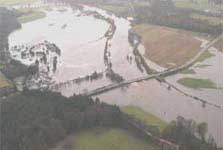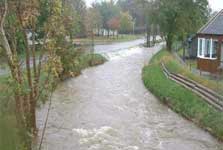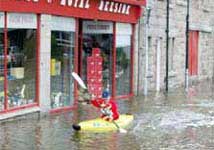Aberdeenshire Council are responsible for applying the Flood Prevention and Land Drainage Act (Scotland) 1997 throughout Aberdeenshire. Under the Act, the Council are responsible for all non-agricultural ground. This network covers some 4000km of watercourses including the Dee and its tributaries. Recent years have seen growing incidences of flooding on the Dee, particularly in Aboyne and Tarland where many domestic and commercial properties were damaged.
The climate we face within the North East of Scotland not only affects water quantity but is also a major influence on the techniques that can be employed to control flood flows. Flood alleviation methods to cope with very high flows must in turn not impede the ability of the watercourse to maintain compensation flows during periods of drier weather. In addition to the type of works employed, location is of the utmost importance; the most effective solution to a problem will not always be located at the site of that problem. When large flood defences were built in the past, the problems encountered during flooding were sometimes merely moved downstream and the hard engineering ‘solutions’ employed could even exacerbate the problems. Since climate change models have suggested that flood events will become heavier and more frequent in the future, flood prevention works must be designed not only based on historical information but also taking future predictions into account.
Flood Prevention Schemes
The alleviation works in the Tarland Burn catchment are in response to previous flooding, in order to provide the best degree of protection against further flood events. In order to provide a more long term solution by way of reducing the severity of future flood events, the feasibility of creating flood plain storage at various locations within the Tarland Burn catchment has been investigated. A resultant flood prevention scheme is now being developed, with a number of sites being considered for alleviation works proposals.
Aberdeenshire Council’s first flood alleviation demonstration site in the catchment is at the Mill of Gellan. Visit the Tarland Gallery for pictures of progress, or the Tarland Deliverables page for further flood alleviation proposals.
Aberdeenshire Council are also implementing a detailed study of river behaviour and have recently installed flood gauging stations to augment information received from SEPA. This will allow downstream monitoring following the implementation of alleviation measures and could also help reveal further opportunities to attenuate flood flows outwith urbanised or other sensitive areas.
- For more information about flood issues and to access live flood warning information, select this link, or call the flood line on 0845 988 1188.
- For further locally relevant flood information, visit Aberdeenshire Council’s flood pages.
- You can also find useful information on flood risk on the Environment Agency website.
- Follow the links to see reports to the Scottish Executive on climate change and a review of flooding occurrence in Scotland and the implications of climate change.
- WWF have prepared the following briefing: Planning our way out of flood disasters – flood management and river basin planning.






